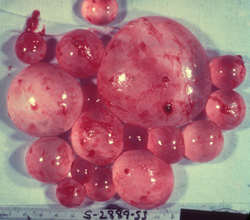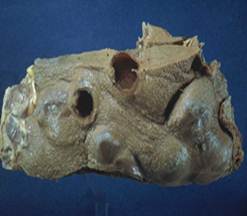| Echinococcosis | ||
Echinococciasis, Hydatidosis, Hydatid Disease Etiology Echinococcosis is caused by several species of Echinococcus, tiny cestode para-sites in the family Taeniidae. Currently recognized species include Echinococcus granulosus, E. multilocularis, E. vogeli, E. oligarthrus and E. shiquicus. E. granulosus causes a type of echinococcosis known as cystic echinococcosis, unilocular echinococcosis or cystic hydatid disease. Transmission and Life Cycle Echinococcus species have an indirect life cycle, and must develop in both an intermediate and a definitive host. In many cases, the parasite cycles through specific predators or scavengers, and their prey. The definitive hosts for E. granulosus s. l. (canids, felids, and hyaenids) become infected when they ingest cysts (metacestodes) in the tissues of the intermediate hosts. Feeding the viscera of intermediate hosts to dogs perpetuates cycles in domesticated animals. The cysts develop into tapeworms, which mature in the hosts small intestine. Gravid proglottids or eggs are shed in the feces, and are immediately infective. Humans can also be infected. If an intermediate host ingests the eggs, the larvae are released, penetrate the intestinal wall, and are carried in blood or lymph to the target organs. Parasites can develop into cysts in many different organs, but they are found most often in the liver and, less frequently, the lungs. Transmission to humans Humans act as intermediate hosts for Echinococcus spp., and are infected when they ingest tapeworm eggs from the definitive host. Clinical Signs The symptoms of echinococcosis depend on the size, number and the location of the metacestodes. Until the cysts become large enough to damage adjacent tissues and organs, they are usually asymptomatic. The clinical signs are those of a mass lesion. E. granulosus s. l. cysts can remain asymptomatic for many years. They are usually well tolerated until they cause pressure on surrounding tissues. The symptoms resemble those of a slowly growing tumor. Although most people have only one cyst, multiple cysts can be found. Approximately 60-70% of E. granulosus s. l. cysts occur in the liver and 20-25% in the lungs.
Treatment Cysts are often removed surgically. Prevention Controlling Echinococcus spp. that occur in domesti-cated animal cycles, such as E. granulosus G1 in the sheep/dog cycle, reduces human exposure. In particular, dogs should not be fed the entrails from livestock at slaughter. |
||
References:
|




